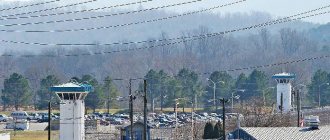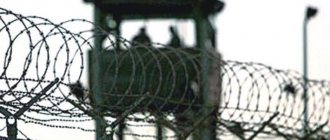In 2021, it is not customary in society to divide people into certain groups, castes and classes.
However, this rule does not work in places of deprivation of liberty, where for many decades a strict classification of all convicts into different groups (or suits, as they say in the zone) has been practiced.
Each suit differs from each other in its rights and prison status. In addition, not only the prisoners themselves are divided by color, but also the places of their imprisonment.
So, all zones are divided into “black” and “red”. In this article we will take a closer look at the question: what is the red zone?
Features of the “red zone”
“Red Prison” is an evaluative term that, although used in world practice, is more typical of the vocabulary of prisoners. What does it mean?
The “Red Zone” is a prison in which absolutely everything must comply with modern legislation.
Here, all questions or problems of prisoners are resolved by the administration of the colony, therefore, as a rule, in the “red zone” for all prisoners the highest authority is held by none other than the administration of the colony.
Even complaints from convicts, and complaints still tend to leak through the walls of the colony, and then first of all they pass through its administration.
The administrations of such prisons, for their part, can simply ignore the numerous complaints and petitions of their prisoners.
In fact, the term “red zone” means such a use of legislative norms in relation to the detention of prisoners, which is characterized by special meticulousness, severity and even intrusiveness.
Practice shows that prisoners in the “red zone” suffer more from the nagging of the institution’s administration itself than from the punishment to which the court sentenced them.
The concept of “red zone” is unofficial, it does not have a strictly defined definition, however, in practice, the “red zone” is characterized by the following number of features, each of which can occur in such prisons:
- strictness in the execution by convicts of all norms not only of internal orders of the prison administration, but also of other correctional codes;
- prisoners do not have the right to violate any instructions from the camp authorities regarding their appearance, as well as the condition of their clothing;
- Each convict must strictly adhere to certain rules in construction, going to work assignments, and also unquestioningly follow the established daily routine.
In the “red zone”, a prisoner will be subject to extremely harsh punishment for even the slightest violation of order or act of insubordination.
As a rule, disobedient people face:
- ban on dating;
- deprivation of your legal right to receive transfers;
- placement in a punishment cell (punishment cell);
- seclusion in a PKT (cell-type room) for a period of up to six months;
- changing the regime of detention of a convicted person;
- and even an increase in the sentence.
All of the above methods of punishment are permitted under modern legislation. How, then, are the “red zones” different? In such places, punishments differ in their purpose.
Thus, the administration of such an institution, having decided to cruelly punish someone, is not guided by the intention of correcting the wrong behavior of the convicted person. On the contrary, the authorities of the “red zones” want to break the personality of the rebellious, which is no secret for the prisoners.
It is well known that in every prison such activists (convicts who are assistants to the administration) are despised. Despite the fact that the employees humiliate them, this does not prevent them from selfishly using them in their own interests, namely, to control any processes taking place in the prisoners’ cells.
Moreover, activists are not at all above carrying out extremely humiliating tasks from the administration, which most convicts will not do.
Therefore, if the authorities want to introduce the “red movement”, then in such institutions the managers of the household, those responsible for discipline and other “wool” lose all fear and shame (“wool” are convicts who report any information to the authorities).
In “red zones,” jailers do not issue a warning or a stern reprimand to a prisoner who has stumbled . If it comes to violating the order, then in such camps they are punished almost immediately, despite the fact that the punishment is constantly increasing, regardless of the degree of seriousness of the offender’s offense.
Therefore, prisoners in such prisons live in constant fear of being put on trial for disobedience, the imposition of an additional term of arrest, or a change in the regime of their detention.
Prison suits
Zone suits are the division of all prisoners into unique groups that differ from each other in prison status, rights and concepts.
In absolutely any prison or colony, there is a clear distinction between all prisoners into certain groups or stripes: “thieves”, “men”, “goats” and “roosters”. There are also so-called intermediate groups, which vary depending on the specific place of deprivation of liberty. Such “intermediate” castes include “roosters”, “lowered”, “offended” and others.
What is the difference between the “red zone” and the “black”?
“Red zone” and “black” are rather an informal name, for those knowledgeable in the criminal world and among the “cops”.
The “Red Zone” is a colony in which the prison authorities rule the roost, using for their own purposes prisoners who are ready to cooperate with the administration, sometimes on their own initiative or taken on a hook.
“Black zones” include institutions where the main thing is the “thieves’ law”, with their own established rules, rituals and traditions.
There is also the so-called position of overseer, as a rule, with the tacit approval of the colony administration - this is a special caste of managers in the zone.
What is also typical for the “red zones” are certain regimes for keeping prisoners. They always have:
- punishment cell or punishment cell;
- separate common barracks;
- quarantine - you enter it immediately upon arrival or in case of suspected disease.
“Black zones” are a peculiar product of the unstable financial situation in the state, when institutions of this kind are practically not funded or are sent to survive.
Living conditions in such colonies are understandably terrible, sanitary standards are low, there is practically no medical care, and the food is very poor.
Taking into account such factors, the leadership of the colony is forced to turn a blind eye to the fact that prisoners themselves solve most everyday problems. In fact, this is how they have a chance to survive.
In the “black” colony, prisoners live under the laws of thieves, and to cooperate with the administration and work is not according to concepts, that is, it is not accepted, and even punishable.
There is a rare guest of renovation and well-kept premises. This is a special habitat where the fittest survive.
In the “red” zones, all new arrivals are required to give written consent that they renounce the concept of thieves. So the authorities are trying to re-educate the convicts from the very beginning and force them to cooperate.
Finding a business is not a problem
The reason for the conflict between the former security officer and the management was a disagreement in the understanding of justice. He noted that the FSB has its own system of values, and its members do not welcome it when people who are not concerned are told about it. This is called professional ethics. New players to the game should accept the existing rules rather than create new ones. Roman says that he always did his job and expressed his opinion directly.
Roman was offered to move to work in another region, but he did not agree. Then he was framed. He says that the setup follows the standard pattern: they fabricate a case of bribery or attribute fraudulent actions. Roman fell under the second option, since he never took bribes and in general it was difficult to find anything illegal in his activities. But he had one friend to whom he had previously lent a large sum.
It all started with a small amount of ten thousand rubles for the school needs of children. Since Roman had a large salary, he agreed to help. A few days later, the friend returned the debt. Then she asked for 30-40 thousand and gave it. Thus, she managed to gain trust. Then she asked for 150 thousand in debt to open her own business. Gradually, a substantial amount accumulated - about a million rubles.
At some stage, the woman was caught cheating and they decided to use it against Roman. She was given an ultimatum: testify against him or her children would be sent to an orphanage. She took the simple route, choosing the first option. The woman decided that she could not repay the debt and would get off with a suspended sentence. She signed the protocol drawn up for Roman. In addition, she was offered to testify against Roman’s leader, but she did not agree to do so.
During the court hearing, she told how she deceived the investigation. But that was no longer important.
At the trial, she was unable to put together even a few words. Despite this, written testimony against Roman was sufficient for the investigation and trial. As a result, the prosecutor simply announced her testimony to the court, which was compiled by the investigator, and no one began to investigate further. Roman was imprisoned.
God sees everything. The employees who compiled the case very soon lost their jobs due to discreditable circumstances. One was even convicted of fraud and ended up in prison.
Where are the “red zones” in Russia?
Is there a list of red zones in Russia? Recently, it is rare to see the “red zone” in its pure form. Experts say that now it can be said that almost all prisons have become “red”.
Why? The fact is that the Federal Penitentiary Service is increasingly insisting that every convict strictly fulfill all the duties and rules established by the prison administration.
In addition, the division into “red” and “black” zones is no longer as relevant as it was before, and the very boundaries that distinguish one suit from another have long been erased. A feature of this figurative division is the method of management of prisoners by the camp authorities.
In the first case, the administration itself controls everything, and in the other, they use the help of a criminal authority chosen directly by the convicts themselves.
If we talk about the history of the famous “red zones”, then it is worth mentioning the famous colony in Belgorod in the early 2000s.
What she became famous for:
- The permissiveness of the jailers was absolutely unpunished - they actively used both physical and psychological measures of influence on prisoners.
- Convicts were unable to obtain justice because they were not allowed to file a complaint or request a meeting with the prosecutor.
- Prisoners were taken out on work assignments, for walks, and to the canteen strictly in accordance with the regulations and under the close attention of the guards and guard dogs.
- Convicts were strictly forbidden to communicate between cells.
- Inappropriate statements were immediately punished either by numerous beatings with batons, or even by unleashing the dogs.
It is noteworthy that such inhuman conditions of detention of prisoners were fueled by extremely poor, low-quality food.
So, the “red zone” is a place where all kinds of crime bosses are deliberately taken for “re-education” - or withdrawal.
Any disobedience or violation of the statute is immediately punished not just by a reprimand, but by placement in a punishment cell, PKT, or by the court, which in turn can add a sentence or transfer the prisoner to a higher-security prison.
Conditions of detention in a maximum security colony
Persons whom the court considered the most dangerous to society and, accordingly, require strict isolation are kept here. These are those who have committed, for example, the intentional murder of two or more people or a contract killing. They also end up in such a colony for recidivism.
Convicts are kept in locked cells. Beds are in two or three tiers; an area of no more than 7 m² is allocated per prisoner. 4 parcels and 4 parcels per year are allowed; three long and three short dates. You cannot spend more than 2 minimum wages on food in the colony stores.
And, of course, the main difference is the contingent. In a maximum security colony, a “first mover” is a rarity. Most of those convicted are those who chose a life of crime as their life credo.
White Swan
Not a single prisoner left this prison alive. The institution houses life-sentenced prisoners. "White Swan" is not the official name of the prison. It is believed that the institution earned it as a result of the fact that convicts are led along the corridor in a certain position. The prisoner should lean forward at a right angle and place his arms back.
The prison is known for its strict regime. Prisoners can even receive letters only once every 10 years.
What is a correctional facility
A correctional colony is a place where people sentenced to imprisonment are kept, who have greater freedom of movement and less limited civil rights.
What modes are there?
There are four types of regimes in correctional colonies:
- general;
- strict;
- special.
General regime colonies are correctional institutions where convicts sentenced to imprisonment who entered this correctional institution, as well as convicts transferred from light and strict conditions of serving their sentences, serve their sentences.
People from light and strict conditions of imprisonment, as well as convicts from other general regime correctional institutions, go there. These are male convicts who have committed serious crimes and have not previously been prosecuted, as well as female prisoners imprisoned for committing serious and especially serious crimes, regardless of the fact and type of recidivism.
According to Article 121 of the Penal Code of the Russian Federation, the conditions for serving in colonies of this type are as follows. Prisoners can:
- spend up to nine thousand rubles a month on food and personal items;
- annually arrange six short dates and four long-term ones;
- receive six parcels or transfers, as well as six parcels throughout the year;
- leave the correctional facility twice a month on weekends or holidays to visit minor children, but within the territory of the colony;
High security colonies are places of stay for male convicts who have committed intentional crimes of special gravity, if they have not previously served a sentence of imprisonment, and for male persons who have committed a dangerous recidivism, if they have previously been imprisoned (Article 58 of the Criminal Code of the Russian Federation ).
These institutions require more stringent conditions of detention:
- spending on food and personal needs is limited to 7,800 rubles each month;
- four parcels and four parcels per year;
- three short and three long dates;
- accommodation in hostels with a lighter version of punishment, and in closed premises (Article 123 of the Penal Code of the Russian Federation).
Special regime colonies are intended for persons who have violated criminal law in a serious form or have committed a particularly dangerous recidivism. In many respects, the conditions here are similar to prison conditions.
Prisoners can:
- live both in dormitories and in specialized cells;
- have two short and one long dates during the year;
- receive two or three parcels annually and one or two parcels, depending on the severity of the crime committed and the prescribed conditions for serving the sentences;
- They are allowed to spend an amount of six thousand six hundred rubles on food (in accordance with the provisions of Article 125 of the Penal Code of the Russian Federation).
There are also settlement colonies
Here citizens serve their sentences who have committed a crime for the first time through negligence, or who have intentionally violated the law, but within the limits of a minor or moderate crime. Living conditions here are more comfortable and loyal
Women and men live here together, not isolated from each other, in dormitories. They retain most freedoms:
- the right to wear civilian clothes;
- have a passport;
- move freely throughout the territory of the settlement and even leave it without leaving the adjacent municipal facility;
- arrange an unlimited number of dates;
- spend on your needs a limit of funds that is not regulated by law.
There are no guards assigned to them, but they are under the supervision of the colony leadership. They have the right to study by correspondence in higher and secondary vocational educational institutions. Convicts with no complaints in terms of behavior and discipline are allowed to live with their families on the territory of the colony. In case of disciplinary sanctions, they can be transferred to institutions of a more strict type (Article 129 of the Penal Code of the Russian Federation).
Educational colonies are intended for minor citizens. They live there in normal, simplified and preferential conditions, depending on which the amount of money that can be spent per month on food is determined; number of dates and parcels per year.
Inmates of educational colonies have the right to live in dormitories or in isolated premises, to take a walk at any time without limiting its duration, but within the territory of the colony (Article 133 of the Criminal Executive Code).
"A comfortable place for a person to live"
The name of the village of Elban in the Khabarovsk Territory in the language of the Ulchi, a small people living in the Lower Amur basin, means “a convenient place for a person to live.” Ironically, it is there that the first and only zone for life prisoners in the Far East is located - correctional colony No. 6 (IK-6). Elban was founded in the mid-30s of the 20th century, during the construction of the Volochaevka - Komsomolsk-on-Amur railway line. Construction work, as often happened at that time, was carried out by convicts from one of the Gulag units.
"Black Dolphin": a prison for lifers
Correctional Colony No. 6 of the Office of the Federal Penitentiary Service for the Orenburg Region (official name) owes its poetic name to the fountain with a sculpture of a black dolphin located in the courtyard of the institution. This prison can house 1,600 inmates. Currently, 863 people are serving sentences there. The number of prison staff is even higher - 900 people. The administration of the colony strictly maintains security. Such precautions bear fruit - no one has ever escaped from this place.
The Black Dolphin prison for lifers is famous for its strict daily routine and harsh rules for keeping prisoners. Random people don't end up there - this prison is intended for the most hardened criminals. So, for example, Vladimir Nikolaev, a famous Russian cannibal, who in the 90s killed two of his drinking buddies and used their meat as food, is serving his sentence there. Nikolai Astanov will sit there until the end of his days - he killed an entire family and burned their bodies in the forest. The lives of these criminals and other non-humans are built according to a single algorithm, day after day, year after year:
- Rise at 6 am. From this moment until lights out, prisoners are prohibited from sitting or lying on their bunks.
- The size of the chambers is 4 x 5 square meters. m. In such a “cage” there are one or two prisoners. The “neighbors” are selected by a psychologist.
- Impossibility of being left alone: prisoners are monitored 24 hours a day, 7 days a week. It is forbidden to cover your head with a blanket. The duty officer comes by every 15 minutes.
- When transferred from a cell to other rooms, prisoners are blindfolded to disorientate them. They move bent over to eliminate the possibility of escape.
- There is no dining room here. Food is pushed through holes in the doors. The menu is not very varied - porridge, soup, bread.
- Every day, an hour and a half - a walk in the fresh air, in any weather. At this time, the administration checks the cameras for the presence of prohibited items.
“Black Dolphin” is not a prison where people end up “just like that,” having lost their way, through stupidity or misunderstanding. These prisoners are responsible for a truly enormous number of crimes. The number of lives that these 800-plus people took is more than 3,500. 4 lives for each criminal. Scary numbers.
Sailor's silence
The history of this establishment dates back to 1775. It was built as a straithouse for swindlers and thieves. After some time, several more buildings were erected to house prisoners convicted of murder and other crimes. At the same time, the strait house was named the Moscow Correctional Prison.
A correctional facility was created on the basis of an existing prison in 1918, when there were many homeless minors on the streets committing assaults and thefts. The establishment also changed its name. Now it was the Reformatory. And after some time, patients with tuberculosis were kept in separate buildings.
Matrosskaya Tishina for the detention of adult convicts was founded in 1946, almost immediately after the end of the war. At first, oligarchs were detained there for fraud, the party elite for bribes and similar crimes. Later, dangerous criminals began to be kept in prison. Personalities such as A. Solonik, a well-known killer in criminal circles, and V. Ivankov, known to the world as Yaponchik, served their punishment for what they did in Matrosskaya Tishina.









